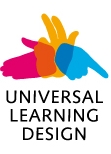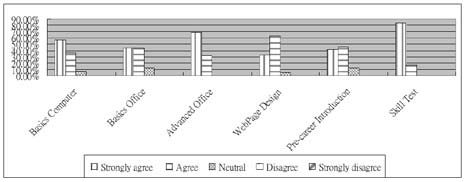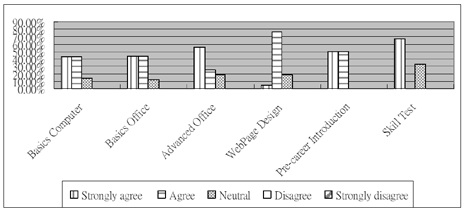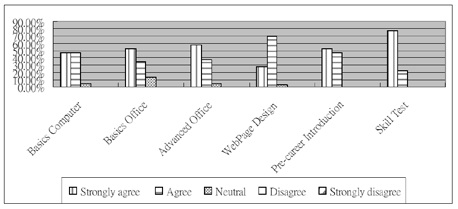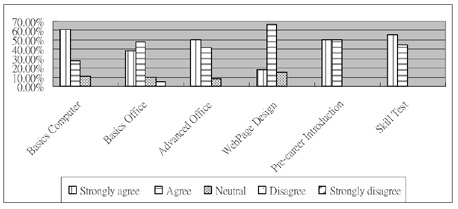Digital participation is a basic human right for modern citizens; however, the digital division still bars people with disabilities from participating in the digital society and e-learning environment. The government in Taiwan has made many efforts to construct the Web accessibilities and focus on developing accessibilities for e-learning environment. To improve the digital participation and enhance their computer skills for persons with disabilities, it is necessary to develop multiple solutions for their e-learning needs. We have provided e-learning services for persons with disabilities in Taiwan. Our e-learning platform provides web accessibility functions according to the web accessibility guidelines. This study is to discuss the needs for persons with disabilities and to explore whether they can apply information technology to participate in digital learning.
1 Introduction
Information technology plays a significant role in our daily life. It can also assist people with disabilities to participate in educational, vocational and other daily activities in a variety of ways [1, 2, 3]. In recent years, several developed countries in Europe and the United States of America have devoted to constructing the Web accessibility with the purpose of promoting the e-learning environment for persons with disabilities. For example, there has been the push by the U.S. Department of Education and technology leaders to integrate technology with teaching and learning in schools. The plan noted the persons with disabilities also enjoy the equal chance to use IT or digital learning [4].
Additionally, the “Section 508” in the U.S. with Disabilities Act mandated that all students have accommodations or access to use online resources. In Europe, the eEurope action plan developed by European Union pondered as well the demand of digital participation for the persons with disabilities in order that they can access information and take full advantage of the information society.
Taiwanese government proposed “Taiwan Digital Archives Expansion Project” in 2002 and the reactive plan of digital learning included “e-learning for all” and “narrowing the digital divide” and other projects. The projects expected to set up a highquality digital learning environment. In order to minimizing the domestic digital divide, RDEC (Research Development and Evaluation Commission Executive Yuan) referenced from international standard WCAG 1.0 (Web Content Accessibility Guideline) to make the Accessible Web Development Guidelines (AWDG) in 2003. RDEC also drew up the policy and schedule to advance the Web accessibility. Taken as a whole, the government in Taiwan has obvious attention these issues on the policy. However, the improvement of Web accessibility and the accessibility for persons with disabilities is only providing the basis of accessing information; it is still not enough for persons with disabilities to participate the digital learning.
Digital participation is a basic human right for modern citizens. In order to improve the digital participation for persons with disabilities, it is necessary to develop multiple solutions. Yao-Ming Yeh et al. had developed the initial Web-Accessibility elearning platform for person with disabilities [6]. It was an integral solution program which allowed people with disabilities to take part in e-learning more easily. It included Web-Accessibility e-learning platform, Web-Accessibility e-learning courses and Web-Accessibility e-learning services. In Web-Accessibility e-learning platform, it should be able to offer universal keyboard operations and conform to the web accessibility standard. In Web-Accessibility e-learning courses, it needs to consider demands of each disability learner in operation and cognitive learning. In Web-Accessibility e-learning services, it should be able to assist each disability student to exclude learning disorder and guide them to adaptive learning [5, 6].
The purpose of this study was to promote the information access for persons with disabilities and to explore whether they can apply information technology to participate in digital learning.
2 Methods
The methods of this research are as following:
2.1 Participants
There were 402 participants with a variety of disabilities, ranging from physical disability, visually impaired, hearing impaired, psychiatric disability, etc. accessed in Web-Accessibility elearning platform.
2.2 Participants
The Web-Accessibility e-learning platform was adopted to conduct the experiment. In this research, the Web Accessibility Service established by RDEC in Taiwan was used to identify e-learning platform accessibility. Machine identify results showed that the platform conformed level “double-A” to Accessible Web Development Guidelines (AWDG).
In terms of Web-Accessibility e-learning courses, there were 6 subjects (basic computer, basic office, advanced office, webpage design, pre-career introduction, proficiency check skill) set up in the Web-Accessibility e-learning program. Each virtual class includes 2–7 subjects and each subject had more than lhr courseware. And the development of e-learning courses was based on ADDIE model [5].
For Web-Accessibility e-learning services, the project provided e-tutor services for asynchronous e-learning. In addition, the services also held 1 synchronous discussion seminar for each class; each seminar lasted more than 90 minutes (see Figure 1).
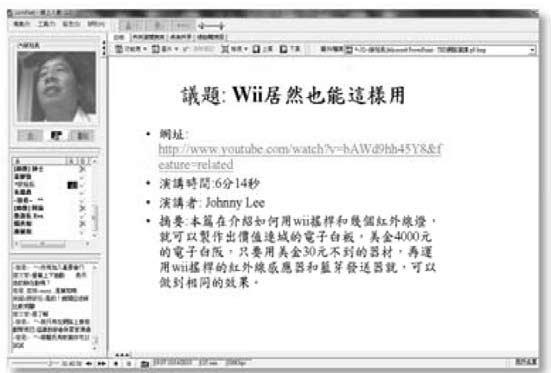
[Fig. 1] Synchronous discussion seminar.
Besides research instrument described above, in order to realize the effect of e-learning for the participated learners, the researchers designed the 5-point Likert-type scale questionnaire, the survey namely “The Web-accessibility e-learning for digital participation”. The content of questionnaire included understanding the satisfaction of members with e-learning materials, user interfaces design, learning services and learning performance. IF members filled out questionnaire with high score, it reflected better satisfaction.
3 Discussion
The data analysis of digital participation for persons with disabilities on a Web-Accessibility e-learning platform is as following:
3.1 Data analysis of participants
The e-learning platform served 402 participants with a variety of disabilities in this study. As shown in Figure 2, approximately 50 % of the participants were physically disabled, and the remaining ones were visually impaired (4 %), hearing impaired (9 %), cognitive disability (8 %), psychiatric disability (12 %) and others (17 %).
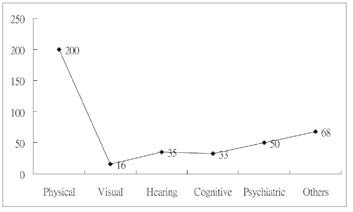
[Fig. 2] Participants enrolled in Web-Accessibility e-learning.
There were 6 classes set up in the Web-Accessibility e-learning platform. The participants of novice would enroll the basic classes and the advanced learner would enroll in any classes. Table 1 shows the participants enrolled in each individual e‑learning class. The number of participants enrolled in webpage design class was the largest. The number of participants enrolled in Skill Test class was the least. Notably, Skill Test class for certificate required mastery learning and proficient skill, so only a minority of the participants enrolled.
[Table 1] Participants enrolled in each e-learning class
|
Disability/Course |
A |
B |
C |
D |
E |
F |
Total |
|
Physical |
82 |
52 |
71 |
115 |
44 |
8 |
372 |
|
Visual |
5 |
3 |
5 |
6 |
7 |
2 |
28 |
|
Hearing |
15 |
13 |
12 |
20 |
4 |
3 |
67 |
|
Cognitive |
10 |
4 |
9 |
8 |
10 |
2 |
43 |
|
Psychiatric |
19 |
12 |
17 |
24 |
13 |
0 |
85 |
|
Others |
29 |
18 |
30 |
31 |
19 |
1 |
128 |
|
Members (n) |
160 |
102 |
144 |
204 |
97 |
16 |
723 |
Note: Classes: A (Basic Computer), B (Basic Office), C (Advanced Office), D (WebPage Design), E (Pre-career Introduction), F (Skill Test)
3.2 Data analysis of questionnaire
‘The Web-accessibility e-learning for digital participation’ questionnaire enabled us to verify that the effect that participants carried on e-learning. Data analysis of participants responded to the questionnaire is as following:
3.2.1 Satisfaction of participants in content materials
As shown in Figure 3, Over 85 % (strongly agree and agree) of the participants satisfied with the teaching materials of courses and teaching or response from the professional instructors by the Web-Accessibility e-learning platform. The results reflected the majority of participants were satisfied with learning materials.
[Fig. 3] Satisfaction of participants in content materials.
3.2.2 Satisfaction of participants in user interface
Each class had over 80 % (strongly agree and agree) of the participants satisfied with the user interface design and the stability of the Web-Accessibility e-learning platform except Skill Test class. Only 66.67 % of all respondents in Skill Test class strongly agreed that they were satisfied with user interface, but 33.33 % of them remained neutral (see Figure 4). One explanation of this was that only a few of the participants enrolled in Skill Test class and it affected the questionnaire results.
[Fig. 4] Satisfaction of participants in user interface.
3.2.3 Satisfaction of participants in learning services
Almost 87.5 % stated that they were satisfied with the service of the Web-Accessibility e-learning platform, the quality of service of the e-tutor in each class and the service of the toll free customer service line. The results had been very positive and it was also had implications for those conducting researches on participation of persons with disabilities in digital learning. Probably the key drive for persons with disabilities to participate digital learning is the fact that we provided well e-learning services.
[Fig. 5] Satisfaction of participants in learning services.
3.2.4 Learning performance of participants
After participating in the Web-Accessibility e-learning, it was also largely agreed (85 %) that they were satisfied with their own learning results and knew more characteristics and advantages of digital learning. Otherwise, most of them agreed that e-learning was far more effective than traditional teaching in improving the learning results.
[Fig. 6] Learning performance of participants.
4 Recommendations
E-learning has become the major trend of the development with regard to education reform. With the construction of the digital environment, availability of multimedia materials and the quality of good services, the chance for persons with disabilities to participate in e-learning is being offered. Over the past years, the focus of assisting persons with disabilities in digital environment was related to computer access and the apparatus they needed. But more recently, the focus issue has shifted to reflecting the “digital participation “for them.
This research was based on Web-Accessibility e-learning platform to explore the digital participation for persons with disabilities. The present findings contribute to the field’s understanding of the various forces acting on digital participation for persons with disabilities. Part of the results will depend on the quality of the instruction and materials delivered in the e-learning platform. Furthermore, the quality of e-learning services is another possible reason to support digital participation for persons with disabilities. This study should provide a descriptive basis for additional research.
References
[1] Graham, S., MacArthur, C. Improving learning disabled students’ skills at revising essays produced on a word processor: Self-instructional strategy training. Journal of Special Education, 22, 1988. p. 133–153.
[2] Hine, M. S., Goldman, S. R., Cosden, M. A. Error monitoring by learning handicapped students engaged in collaborative microcomputer-based writing. Journal of Special Education, 23, 1990. p. 407–422.
[3] McNaughton, D., Hughes, C., Clark, K. The effect of five proofreading conditions on the spelling performance of college students with learning disabilities. Journal of Learning Disabilities, 30, 1997. p. 643–651.
[4] Riley, R. W. e-learning: Putting a world-class education at the fingertips of all children: The national educational technology plan. U.S. Department of Education, Office of Educational Technology, 2000.
[5] Yeh, Y. M., Yeh, C. C., Wang, H. P., Chou, A. M., Lin, Y. L., Chu, C. N. E-learning for People with Cognitive Disabilities on a Web-Accessibility E-learning Platform. Proceedings of the 3rd International Convention on Rehabilitation Engineering & Assistive Technology. i-CREATe, 2009.
[6] Yeh, Y. M., Wu, T. F., Meng, L. F., Chen, M. C., Wang, H. P., Wu, J. G., Chu, C. N., Li, T. Y., Yeh, C. C. Characteristics and Solutions of Digital Divide for People with Physical Impairments in Taiwan. 11th International Conference on Computers Helping People with Special Needs, Lecture Notes in Computer Science, 5105, 2008. p. 1332–1339.
